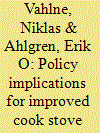|
|
|
Sort Order |
|
|
|
Items / Page
|
|
|
|
|
|
|
| Srl | Item |
| 1 |
ID:
128003


|
|
|
|
|
| Publication |
2014.
|
| Summary/Abstract |
The Fukushima disaster has lead the French government to release novel cost information relative to its nuclear electricity program allowing us to compute a levelized cost. We identify a modest escalation of capital cost and a larger than expected operational cost. Under the best scenario, the cost of French nuclear power over the last four decades is View the MathML source (at 2010 prices) while in the worst case it is View the MathML source. On the basis of these findings, we estimate the future cost of nuclear power in France to be at least View the MathML source and possibly View the MathML source. A comparison with the US confirms that French nuclear electricity nevertheless remains cheaper. Comparisons with coal, natural gas and wind power are carried out to find the advantage of these.
|
|
|
|
|
|
|
|
|
|
|
|
|
|
|
|
| 2 |
ID:
132674


|
|
|
|
|
| Publication |
2014.
|
| Summary/Abstract |
After the Fukushima nuclear accident, more and more attention has been paid to the safety issues of nuclear power in China, even though it is a clean and necessary substitution to coal power. Due to the consideration about the uncertainty of nuclear safety, the local citizens may resist the nuclear power programs in their neighborhood, as indicated by the anti-nuclear movement in Jiangmen 2013. This phenomenon is often related to the public perceptions of "not-in-my-back-yard" (NIMABY). The explosion of anti-nuclear movements will impose adverse effects on the nuclear power decision-making in China. Based on the Contingent Valuation Method (CVM), we evaluate the public Willingness-To-Pay (WTP) for avoiding the construction of nuclear power plants in their neighborhood. Moreover, we analyze whether more information about nuclear energy could improve the public acceptance. Our results show that the comprehensive information will decrease the public risk perception of nuclear power and increase the public support for nuclear power policy. This paper further suggests that China×s decision makers should improve policy transparency and encourage the public involvement of nuclear energy decision making.
|
|
|
|
|
|
|
|
|
|
|
|
|
|
|
|
| 3 |
ID:
127865


|
|
|
|
|
| Publication |
2014.
|
| Summary/Abstract |
Russian energy policy is usually considered in the regional context - in terms of its energy power capability and strength vis-à-vis the EU and the post-Soviet states. This study shows that in order to understand Russia's energy power, even in the regional context of its relations with the EU, it is necessary to consider the impact of international changes in the energy sector. The oil and gas shale "revolutions" represent such a global factor of influence. Even if their consequences are not yet clear, they have already become an important challenge for Russian energy policy and power. This policy-oriented article, guided by neoclassical realism, analyzes what the shale "revolutions" mean for Russia's energy policy and its power capabilities vis-à-vis the EU, how the Russian political elite perceive this development and how Russia reacts to it. In this context, Russian power capabilities look more moderate.
|
|
|
|
|
|
|
|
|
|
|
|
|
|
|
|
| 4 |
ID:
127249


|
|
|
|
|
| Publication |
2014.
|
| Summary/Abstract |
This study analyses battery electric vehicles (BEVs) in the future German power system and makes projections of the BEVs hourly load profile by car size ('mini', 'small', 'compact' and 'large'). By means of a power plant dispatching optimisation model, the study assesses the optimal BEV charging/discharging strategies in grid-to-vehicle (G2V) and vehicle-to-grid (V2G) schemes. The results show that the 2% rise in power demand required to power these BEVs does not hamper system stability provided an optimal G2V scheme is applied. Moreover, such BEV deployment can contribute to further integrating wind and solar power generation. Applying a V2G scheme would increase the capacity factors of base and mid-load power plants, leading to a higher integration of intermittent renewables and resulting in a decrease in system costs. However, the evaluation of the profitability of BEVs shows that applying a V2G scheme is not a viable economic option due to the high cost of investing in batteries. Some BEV owners would make modest profits (€6 a year), but a higher number would sustain losses, for reasons of scale. For BEVs to become part of the power system, further incentives are necessary to make the business model attractive to car owners
|
|
|
|
|
|
|
|
|
|
|
|
|
|
|
|
| 5 |
ID:
128043


|
|
|
|
|
| Publication |
2014.
|
| Summary/Abstract |
Based on a recent technical-economical analysis on the island of Pantelleria, a policy feasibility study for a complete upgrading of the energy system of this Mediterranean Island is carried out. Pantelleria, situated between Sicily and Africa, owns a large potential in terms of renewable energy resources, although there are some obstacles in turning it into a Near Zero Energy system. Starting from a deep energy system audit, the study proposes the project for a near zero energy island, through the efficient transformation of the different existing natural energy resources into electrical energy and heat: the solar, the wind-based and the geothermal systems. In this way, the island can be turned into an almost autonomous system. The main difficulties connected to the implementation of the project can be identified in the national energy policies as well as in the specific local situation, characterized by a strong private monopole on generation and distribution of electrical energy which has no incentive for supporting the costs connected to the energy requalification of the island. On the other hand, the local administrations, involved in the project through bottom-up European policies, do not have the cultural and economic tools to go on with the implementation
|
|
|
|
|
|
|
|
|
|
|
|
|
|
|
|
| 6 |
ID:
128011


|
|
|
|
|
| Publication |
2014.
|
| Summary/Abstract |
Despite the long history of cook stove programs, very few have been successful, often only in areas where biomass is purchased or there is a biomass shortage. Several studies have described how rural households generally rely on several different fuels; which fuels are used may depend on various household characteristics such as location and income. This article explores possible consequences of variations in fuel usage for improved cook stove programs and how this may vary between different areas. Reductions of CO2 equivalent emissions and monetary savings are calculated for hypothetical cook stove deployment using data from a rural energy survey in the V?nh Phúc province of northern Vietnam. The results indicate that the areas may respond differently to the various stove options, both in terms of economy and emission reductions. Furthermore, there are large differences in emission reduction calculations when only Kyoto-gases are included and when non-Kyoto greenhouse agents are added. Assumptions regarding household behavior and stove efficiencies have large impacts on the results, indicating a need for further research on how improved cook stoves may influence households' fuel choices.
|
|
|
|
|
|
|
|
|
|
|
|
|
|
|
|
| 7 |
ID:
132648


|
|
|
|
|
| Publication |
2014.
|
| Summary/Abstract |
The role of biomass in US industrial interfuel substitution in the industrial sector has typically been analyzed using data for the four traditional fuels of coal, oil, electricity and natural gas. However, the use of biomass as an industrial fuel in the US has grown, and now exceeds that of coal. Using data from 1960 to 2011, interfuel substitution in the US industrial sector is modeled with a dynamic linear logit model which includes biomass alongside the other four traditional fuels. Adding biomass to the model reduces somewhat the estimated own-price and cross-price elasticities for the other four fuels, while revealing that biomass and natural gas are substitute fuels. This implies that previous studies excluding biomass may have overestimated the potential for interfuel substitution, giving policy makers an inaccurate impression of the ability of carbon taxes or other environmental regulation to reduce greenhouse gas (GHG) emissions.
|
|
|
|
|
|
|
|
|
|
|
|
|
|
|
|
| 8 |
ID:
132641


|
|
|
|
|
| Publication |
2014.
|
| Summary/Abstract |
A brisk building boom of hydropower mega-dams is underway from China to Brazil. Whether benefits of new dams will outweigh costs remains unresolved despite contentious debates. We investigate this question with the "outside view" or "reference class forecasting" based on literature on decision-making under uncertainty in psychology. We find overwhelming evidence that budgets are systematically biased below actual costs of large hydropower dams-excluding inflation, substantial debt servicing, environmental, and social costs. Using the largest and most reliable reference data of its kind and multilevel statistical techniques applied to large dams for the first time, we were successful in fitting parsimonious models to predict cost and schedule overruns. The outside view suggests that in most countries large hydropower dams will be too costly in absolute terms and take too long to build to deliver a positive risk-adjusted return unless suitable risk management measures outlined in this paper can be affordably provided. Policymakers, particularly in developing countries, are advised to prefer agile energy alternatives that can be built over shorter time horizons to energy megaprojects.
|
|
|
|
|
|
|
|
|
|
|
|
|
|
|
|
| 9 |
ID:
127867


|
|
|
|
|
| Publication |
2014.
|
| Summary/Abstract |
From a biophysical perspective, woody biomass resources are large enough to cover a substantial share of the world's primary energy consumption in 2050. However, these resources have alternative uses and their accessibility is limited, which tends to decrease their competitiveness with respect to other forms of energy. Hence, the key question of woody biomass use for energy is not the amount of resources, but rather their price. In this study we consider the question from the perspective of energy wood supply curves, which display the available amount of woody biomass for large-scale energy production at various hypothetical energy wood prices. These curves are estimated by the Global Biosphere Management Model (GLOBIOM), which is a global partial equilibrium model of forest and agricultural sectors. The global energy wood supply is estimated to be 0-23 Gm3/year (0-165 EJ/year) when energy wood prices vary in a range of 0-30$/GJ (0-216$/m3). If we add household fuelwood to energy wood, then woody biomass could satisfy 2-18% of world primary energy consumption in 2050. If primary forests are excluded from wood supply then the potential decreases up to 25%.
|
|
|
|
|
|
|
|
|
|
|
|
|
|
|
|
|
|
|
|
|